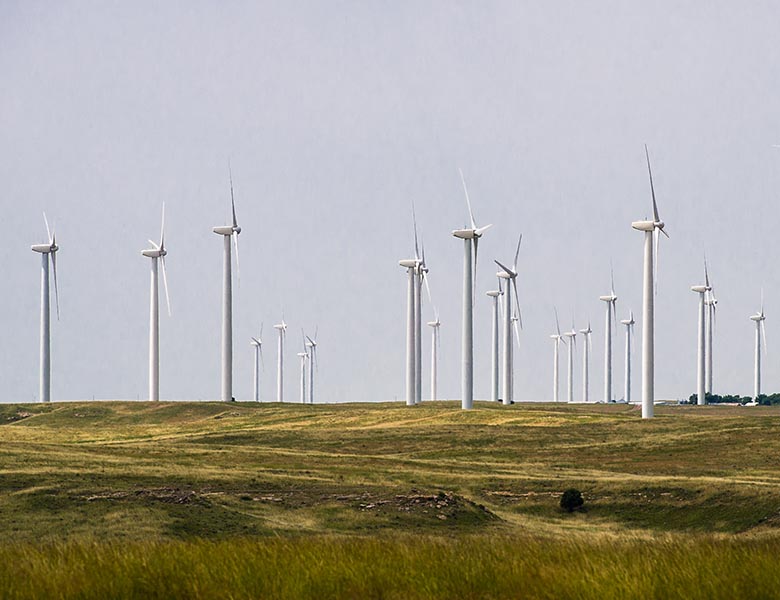Wind Resources Expand With OpenOA Upgrade and Partner Input

The National Renewable Energy Laboratory (NREL) has released version 2.3 of its Open Operational Assessment (OpenOA) software, which helps demystify wind plant operations for wind plant operators.
This latest release includes an improved operational data quality-control toolkit, hourly energy production calculation, and automated date selection for long-term reference data. Version 2.3 also includes a wind plant layout visualization feature for creating interactive maps of wind farms, which was developed with the help of a wind power plant owner.
“OpenOA Version 2.3 includes major enhancements that are designed to improve the usability of the open-source software,” said NREL researcher Jason Fields, who leads the project team that includes Eric Simley, Nicola Bodini, Jordan Perr-Sauer, and Rob Hammond. “The recent release is a direct result of OpenOA’s community of users suggesting updates that would be critical to the software’s usefulness.”
OpenOA launched in 2019 as an open-source platform for sharing data to advance the state-of-the-art science for operational energy assessments and to address the lack of standardization in the wind industry. The code’s modular design makes it possible to facilitate collaboration and methods sharing among wind industry professionals.
Since OpenOA’s launch, more than 100 users have starred the software repository (an action similar to bookmarking a web page or liking a social media post). In addition, over 40 developers have started different forks, or software repositories that enable users to modify the code for their own purposes without affecting the original code.
In a first, the latest version also integrates third-party data. Although being sunset in August 2022, Intertrust’s PlanetOS weather data application programming interface, or API, provides OpenOA users with the weather data needed to estimate long-term energy production at a wind power plant.
“OpenOA has benefited from a community of users whose experiences have improved the software over time,” Fields said. “As a nonproprietary, free software, OpenOA has taken a crowd-sourcing approach to informing its development.”
This first-of-its-kind tool standardizes operational analyses of wind power plants and includes a built-in method for calculating the expected annual energy production over the lifetime of a project. OpenOA’s long-term annual energy production analysis can help wind power plant operators identify and analyze the factors that drive plant performance, determine the accuracy of preconstruction energy yield estimates, and assist with financial transactions involving wind power plants.
To help identify specific sources of discrepancies between preconstruction energy yield assessments and operational energy production—called a gap analysis—OpenOA features methods for estimating electrical losses, availability losses, and turbine ideal energy (the energy produced assuming all turbines are operating normally).
Energy Department Programs Led to OpenOA Development
A validation exercise for wind farm preconstruction energy assessments conducted through the U.S. Department of Energy’s (DOE’s) Wind Plant Performance and Prediction Benchmark initiative led to the development of OpenOA. The benchmark project provided user feedback from eight major wind power plant owners and 10 third-party consultants. Last year, the NREL OpenOA team released the Wind Plant Performance Prediction Benchmark Phase 1 technical report, which details this history.
Also helping shape OpenOA's Version 2.0 was Energy I-Corps, a specialized DOE training program that empowers national laboratory teams with the tools, resources, and relationships necessary to discover potential market pathways for their innovations. Energy I-Corps gave NREL researchers the opportunity to collaborate with and receive user feedback from approximately 70 stakeholders, including wind power plant owner/operators, third-party consultants, analytics companies, open-source software professionals, and researchers.
Currently, a DOE Technology Commercialization Fund project is enabling the OpenOA project team to collaborate with the ENTR Alliance, a wind industry consortium. The goal of this project is to develop an easy-to-use data analysis software package that combines the standard operational wind plant data analysis methods in OpenOA with the ENTR universal wind plant data model. This research supported the PlanetOS feature development.
The OpenOA team is also developing a method for estimating wind turbine wake losses and improving user experience by simplifying the data-importing process and allowing more data-source options.
The OpenOA codebase, written in the common coding language Python, is available through GitHub. External users are welcome to contribute to OpenOA by providing feedback and suggesting new features that will enhance toolkit functionality and develop new methods of data assessment.
Learn more about NREL's wind energy research and tools. And subscribe to NREL's wind energy newsletter for all the latest updates, like this one.
Last Updated May 28, 2025
